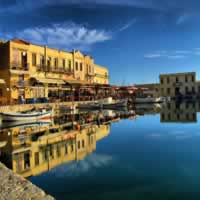Day 1 in Heraklion
Welcome to Heraklion! Arrive at the airport and proceed to your hotel. After check in, head to Koules Fortress, which dominates the lovely Venetian harbor. Then, follow the city's medieval walls around, taking in the Historical Museum, Agios Minas and Agia Ekaterini (be sure to see the Byzantine Collection exhibited here) before delving into Minoan history at Heraklion's Archaeological Museum.
After lunch, make your way to the excavated ruins of the legendary Palace of Knossos, just outside Heraklion. This is the largest and most famous Minoan site in Greece. Reconstructions of the original courtyards, private apartments, baths and frescos will give you a good idea of palatial life in Minoan times. Legend has it that this palace was the location of the Labyrinth built by King Minos of Crete to keep away the mythical creature Minotaur, who was half bull and half man. Afterwards, head to Archanes to explore the ruins of the summer palace and necropolis.
Later, admire the church of Agios Titos (where the skull of Saint Titus is guarded) as well as the Venetian Loggia that serves as Heraklion's town hall before doing some shopping in the center. Tonight enjoy a bit of people watching while dining in one of the many cafes surrounding Lion's Square (Morozini Fountain).


Day 2 in Heraklion
Wake up early this morning and head south to Prinias for a brief stop at the archaeological site of Rizinia with its temples dating from the 7th century BC. Then continue on to the Doric town of Gortyn where the famous Minoan law code was excavated. You will also be able to visit the remains of the Roman Odeon and Praetorium as well as an acropolis, a temple of Apollo and the sacred plane tree where Zeus is said to have married the princess Europa. Following your visit of Gortyn, stop in the village of Agioi Deka, one of the prettiest villages of Crete, then make your way west to the village of Kasteli for a relaxing lunch.
This afternoon, visit the Minoan Palace of Phaestos, the second most important Minoan site in Crete, after Knossos. The design of the palace is a copy of Knossos, but smaller in scale. Next, head southwest to the famous Caves of Matala. Protected by the Archaeological Service, these rock formations above the beach were used as shelter in prehistoric times and as tombs in the Hellenistic and Roman period. South of the caves there is a huge rock formation known as the rock of Theosyni that offers a beautiful view of Messara Bay. Next stop is the archaeological site at Agia Triada. The Minoan name of the site is unknown, but here you can see ruins of the Royal Villa. Some of the most important findings of the Minoan period were excavated in Agia Triada (including the only stone sarcophagus ever found in Crete) and are currently on display at the Archaeological museum of Heraklion.
Finally, make your way inland to Zaros, a mountainous village known for its pure water and lush landscape. Be sure to visit the Monastery of Agios Antonios Vrontissi with its beautiful 14th century frescoes and 15th century marble fountain, adorned with carvings representing God, Adam, Eve and other figures standing near the rivers of Paradise. Nearby, the picturesque village of Nyritos is worth seeing for its traditional architecture. Tonight, have dinner in a local tavern in Zaros or return to Heraklion for a meal in one of the lively squares around town.



Day 3 in Heraklion
Today is a great day to explore other areas of the island. Head west to the cities of Rethymnon and/or Chania to admire their Venetian and Ottoman architecture, lovely old town centers, harbors, museums, churches and mosques. People watch and enjoy the atmosphere from a waterfront taverna overlooking the port. Also, in the southern part of Chania prefecture, you can visit the Venetian Fortress at Frangokastello.
Alternately, you may decide to go east toward Malia to explore more Minoan ruins. Malia is also a popular beach resort with fine white sand and crystal clear water. And only a short distance away you will find the Cave of Milatos and the small Church of Saint Thomas as well as the Venetian Fortress at Spinalonga. If you decide to visit this area, we recommend staying for dinner and drinks in Malia, which is the most famous nightlife spot in Crete.


Additional Days in Heraklion
Should you be able to spend additional days in Heraklion, you may want to visit some other areas in town. Visit the church of Agia Triada then proceed to the Gate of Bethlehem, where you will find the museum dedicated to the famous Cretan painter Domenicos Theotokopoulos, also known as 'El Greco'. The museum includes copies of his paintings and costumes of the awarded movie 'El Greco' (2007), directed by the Greek director Iannis Smaragdis. Outside the walls, in the tower of Martinengo lies the Tomb of Nikos Kazantzakis, the famous Greek writer who was born in Heraklion in 1883.
More adventurous types should head to Chania prefecture to hike the Samaria Gorge, Europe's longest gorge. This legendary trail follows a riverbed enclosed by soaring cliffs and ends at the beach at Agia Roumeli. The route is approximately 10 miles and takes about 4 to 7 hours depending on your physical ability. You should be in good physical condition to even consider this hike as it can be very exhausting, especially during the blazing hot summer.
Alternately, you can take your pick from a variety of beautiful beaches like Tymbaki, Kalamaki or Matala in southern Heraklion prefecture or Amoudara or Karteros, which are closer to town. Pack a picnic and head out to enjoy the sun, sand and surf!


Your Last Day in Heraklion
Depart your hotel for the airport for your return home. Please remember to leave enough time to return your rental car before your flight out.
